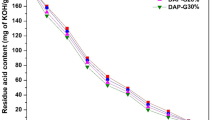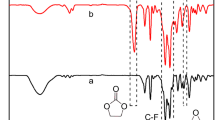Abstract
Bio-based polyurethane (PU) coatings were prepared from novel branched isostearic acid (ISA) and long chains dimer fatty acid. Fatty amide was synthesized by the amidation of ISA with diethanolamine and the required hydroxyl functionality was developed via condensation polymerization with dimer fatty acid to produce polyesteramide polyol. The structure of the synthesized ISA based fatty amide (ISAFA) and polyesteramide polyol (ISAPEP) were identified using Fourier-transform infrared spectroscopy (FT-IR) and proton nuclear magnetic resonance (1HNMR). The number average molecular weight of prepared polyesteramide polyol was assessed by gel permeation chromatography (GPC), while the rheological behavior was examined by the rheometer. Polyurethane metal coatings were developed from polyesteramide polyol, which crosslinks with hexamethylene diisocyanate (PU-H) and toluene diisocyanate (PU-T) and studied the influence of isocyanate structure on final PU coatings. A comparison in the crosslinks density of PU films was investigated by the gel content method. Differential scanning calorimetry (DSC) and thermo gravimetric analysis (TGA) were performed to evaluate the glass transition temperature (Tg) and thermal stability of the PU coatings. The surface roughness of prepared PU coatings was examined by Atomic force microscopy (AFM). The PU coated metal panels and films were examined for swelling resistance, hydrophobicity, mechanical, and coating properties. Results confirmed that bio-based long chain fatty acids provided hydrophobicity, flexibility and impact resistance to final PU coatings. It also noted that PU-T coating resulted in increasing thermal, mechanical, and coating properties compared to PU-H coating and this resulted from the structure of TDI, which contribute to higher crosslink density (i.e. presence of aromatic ring).
Graphical Abstract













Similar content being viewed by others
References
Ionescu M, Wan X, Bilic N, Petrovic ZS (2012) Polyols and rigid polyurethane foams from cashew nut shell liquid. J Polym Environ 3:647–658
Phalak G, Patil D, Vignesh V, Mhaske S (2018) Development of tri-functional biobased reactive diluent from ricinoleic acid for UV curable coating application. Ind Crop Prod 119:9–21
Atabani AE, Silitonga AS, Ong HC, Mahlia TMI, Masjuki HH, Badruddin IA, Fayaz H (2013) Non-edible vegetable oils: a critical evaluation of oil extraction, fatty acid compositions, biodiesel production, characteristics, engine performance and emissions production. Renew Sustain Energy Rev 18:211–245
Lu Y, Larock RC (2010) Soybean oil-based, aqueous cationic polyurethane dispersions: synthesis and properties. Prog Org Coatings 69:31–37
Ca V, Lligadas G, Ronda JC, Galia M (2013) Renewable polymeric materials from vegetable oils: a perspective. Mater Today 16:337–343
Alam M, Akram D, Sharmin E, Zafar F, Ahmad S (2014) Vegetable oil based ecofriendly coating materials: a review article. Arab J Chem 7:469–479
Desroches M, Escouvois M, Auvergne R, Caillol S (2013) From vegetable oils to polyurethanes: synthetic routes to polyols and main industrial products. Polym Rev 52:38–79
Tan SG, Chow WS (2010) Biobased epoxidized vegetable oils and its greener epoxy blends: a review. Polym Plast Technol Eng 49:1581–1590
Kong X, Liu G, Curtis JM (2012) Novel polyurethane produced from canola oil based poly (ether ester) polyols: synthesis, characterization and properties. Eur Polym J 48:2097–2106
Ionescu M, Radojcic D, Wan X, Shrestha ML, Petrovic ZS, Upshaw TA (2016) Highly functional polyols from castor oil for rigid polyurethanes. Eur Polym J 84:736–749
Fan X, Deng Y, Waterhouse J, Pfromm P (1998) Synthesis and characterization of polyamide resins from soy-based dimer acids and different amides. J Appl Polym Sci 68:305–314
Shukla SK, Srivastava K, Srivastava D (2015) Studies on the thermal, mechanical and chemical resistance properties of natural resource derived polymers. Mater Res 18(6):1217–1223
Zhang Y, Maxted J, Barber A, Lowe C, Smith R (2013) The durability of clear polyurethane coil coatings studied by FTIR peak fitting. Polym Degrad Stab 98:527–534
Chaudhari AB, Tatiya PD, Hedaoo RK, Kulkarni RD, Gite VV (2013) Polyurethane prepared from neem oil polyesteramides for self- healing anticorrosive coatings. Ind Eng Chem Res 52:10189–10197
Rajput SD, Mahulikar PP, Gite VV (2014) Biobased dimer fatty acid containing two pack polyurethane for wood finished coatings. Prog Org Coat 77:38–46
Kathalewar M, Sabnis A, Melo DD (2014) Polyurethane coatings prepared from CNSL based polyols: synthesis, characterization and properties. Prog Org Coat 77:616–626
Parcheta P, Ewa G, Datta J (2020) Effect of bio-based components on the chemical structure, thermal stability and mechanical properties of green thermoplastic polyurethane elastomers. Eur Polym J 123:109422
Petrovic ZS, Ferguson J (1992) Polyurethane elastomers. Prog Polym Sci 16:695–836
Panda SS, Panda BP, Nayak SK, Mohanty S (2018) A review on waterborne thermosetting polyurethane coatings based on castor oil: synthesis, characterization, and application. Polym Plast Technol Eng 57:500–522
Alagi P, Jin Y, Seog J, Chul S (2016) Efficient and quantitative chemical transformation of vegetable oils to polyols through a thiol-ene reaction for thermoplastic polyurethanes. Ind Crop Prod 87:78–88
Nelly M, González G, Börjesson P, Levi M, Turri S (2018) Development and life cycle assessment of polyester binders containing 2, 5-furandicarboxylic acid and their polyurethane coatings. J Polym Environ 26:3626–3637
Raghunanan LC, Fernandez-prieto S, Martínez I, Valencia C, Sánchez MC, Franco JM (2018) Molecular insights into the mechanisms of humidity-induced changes on the bulk performance of model castor oil derived polyurethane adhesives. Eur Polym J 101:291–303
Yang LT, Zhao CS, Dai CL, Fu LY, Lin SQ (2012) Thermal and mechanical properties of polyurethane rigid foam based on epoxidized soybean oil. J Polym Environ 20:230–236
Laurichesse S, Huillet C, Avérous L (2014) Original polyols based on organosolv lignin and fatty acids: new bio-based building blocks for segmented polyurethane synthesis. Green Chem 16:3958–3970
Liu X, Xu K, Liu H, Cai H, Su J, Fu Z, Guo Y, Chen M (2011) Preparation and properties of waterborne polyurethanes with natural dimer fatty acids based polyester polyol as soft segment. Prog Org Coat 72:612–620
Prabhudesai MS, Paraskar PM, Kedar R, Kulkarni RD (2020) Sea buckthorn oil tocopherol extraction’s by-product utilization in green synthesis of polyurethane coating. Eur J Lipid Sci Technol 122(4):1–9
Petrović ZS, Zhang W, Javni I (2005) Structure and properties of polyurethanes prepared from triglyceride polyols by ozonolysis. Biomacromol 6:713–719
Thi T, Hoang K, Kim I (2015) Epoxidation and ring-opening of palm oil to produce high-functionality polyols. Aust J Basic Appl Sci 9(8):89–93
Patil CK, Rajput SD, Marathe RJ, Kulkarni RD, Phadnis H, Sohn D, Mahulikar PP, Gite VV (2017) Synthesis of bio-based polyurethane coatings from vegetable oil and dicarboxylic acids. Prog Org Coat 106:87–95
Rajput SD, Hundiwale DG, Mahulikar PP, Gite VV (2014) Fatty acids based transparent polyurethane films and coatings. Prog Org Coat 77:1360–1368
Ngo HL, Dunn RO, Sharma B, Foglia TA (2011) Synthesis and physical properties of isostearic acids and their esters. Eur J Lipid Sci Technol 113:180–188
Ngo HL (2015) Lewis base additives improve the zeolite ferrierite-catalyzed synthesis of isostearic acids. J Am Oil Chem Soc 92:613–619
Riazi B, Zhang J, Yee W, Ngo H, Spatari S (2019) Life cycle environmental and cost implications of isostearic acid production for pharmaceutical and personal care products. ACS Sustain Chem Eng 7:15247–15258
Zvonkina IJ, Hilt M (2015) Tuning the mechanical performance and adhesion of polyurethane UV cured coatings by composition of acrylic reactive diluents. Prog Org Coat 89:288–296
Patil DM, Phalak GA, Mhaske ST (2017) Design and synthesis of bio-based UV curable PU acrylate resin from itaconic acid for coating applications. Des Monomers Polym 20:269–282
Chattopadhyay DK, Webster DC (2009) Thermal stability and flame retardancy of polyurethanes. Prog Polym Sci 34:1068–1133
Chaudhari A, Gite V, Rajput S, Mahulikar P, Kulkarni R (2013) Development of eco-friendly polyurethane coatings based on neem oil polyetheramide neem oil. Ind Crop Prod 50:550–556
Sur S, Choi P, Ko J, Lee J, Lee Y, Kim H (2018) Preparation and properties of DMF-based polyurethanes for wet-type polyurethane artificial leather. Int J Polym Sci 2018:1–9
Pathan S, Ahmad S (2013) Synthesis, characterization and the effect of the s-triazine ring on physico-mechanical and electrochemical corrosion resistance performance of waterborne castor oil alkyd. J Mater Chem A 1(45):14227–14238
Yadav S, Zafar F, Hasnat A, Ahmad S (2009) Poly (urethane fatty amide) resin from linseed oil—A renewable resource. Prog Org Coat 64:27–32
Rajput SD, Gite VV, Mahulikar PP (2014) Renewable source based nonbiodegradable polyurethane coatings from polyesteramide prepared in one-pot using oleic acid. J Am Oil Chem Soc 91:1055–1063
Liu X, Zhang R, Zhu J, Jiang Y (2014) Synthesis and properties of full bio-based thermosetting resins from rosin acid and soybean oil: the role of rosin acid derivatives. Green Chem 15:1300–1310
Mishra V, Desai J, Patel KI (2018) UV/Oxidative) dual curing polyurethane dispersion from cardanol based polyol: synthesis and characterization. Ind Crop Prod 111:165–178
Monteavaro LL, Silva EO, Costa APO, Samios D, Gerbase AE, Petzhold CL (2005) Polyurethane networks from formiated soy polyols: synthesis and mechanical characterization. J Am Oil Chem Soc 82:365–371
Liang B, Zhao J, Li G, Huang Y, Yang Z, Yuan T (2019) Facile synthesis and characterization of novel multi-functional bio-based acrylate prepolymers derived from tung oil and its application in UV-curable coatings. Ind Crop Prod 138:111585
Wang C, Ma C, Lin W (2017) Tailor-made zwitterionic polyurethane coatings: microstructure, mechanical property and their antimicrobial performance. RSC Adv 7:27522–27529
Malkappa K, Jana T (2015) Hydrophobic, water dispersible polyurethane: role of polybutadiene diol structure. Ind Eng Chem Res 54(30):7423–7435
Acknowledgements
The authors thank the Department of Science and Technology (DST-Inspire), Delhi, India for the funding. The authors also would like to thank Croda Chemicals India for provided fatty acid as a gift sample.
Author information
Authors and Affiliations
Corresponding author
Additional information
Publisher's Note
Springer Nature remains neutral with regard to jurisdictional claims in published maps and institutional affiliations.
Rights and permissions
About this article
Cite this article
Paraskar, P.M., Kulkarni, R.D. Synthesis of Isostearic Acid/Dimer Fatty Acid-Based Polyesteramide Polyol for the Development of Green Polyurethane Coatings. J Polym Environ 29, 54–70 (2021). https://doi.org/10.1007/s10924-020-01849-x
Published:
Issue Date:
DOI: https://doi.org/10.1007/s10924-020-01849-x




